Vermouth braised chicken in a vodka cream sauce, with a twist and plenty of olives
Prep: 15 mins
Cook: 45 mins
Total: 60 mins
Servings: 4 servings
A bracingly cold martini is one of life’s little joys. The classic martini is made with gin and dry Vermouth, and the ratio of these two ingredients is a source of passionate debate and varying personal tastes. And then there are those of us who are not ashamed to admit that we also order vodka martinis (this is seen as a sin among martini purists, but turns out it’s really easy not to care what people think about you when you have a martini in your hand). Regardless of the base spirit I pick, I always order my martinis extra-dry with a twist and olives because more is more.
This martini chicken recipe was born mostly out of the practical need to make more of a dent in that massive bottle of dry Vermouth in my fridge. Vermouth is a fortified wine, making it the perfect liquid for chicken to take a warm bath and braise in until fall-apart tender. The vodka sauce brightened with lemon zest and rounded out with a couple dollops of butter and mascarpone is lick-the-plate good; but the low-key real star of this dish is the the creamy and subtle Castelvetrano olive (aka the only olive that matters to me). Drinking a martini while you make this dish is practically a requirement, making this a perfect dish to cook with friends on a lazy Sunday.
What is Vermouth?
Vermouth is a fortified wine and it comes in two varieties: dry and sweet. In this recipe we are using dry vermouth, which is aromatized with a variety of botanicals to yield a low-sugar yet floral taste. It is also the one other key ingredient in the martini cocktail.
What Does It Mean to Braise Chicken?
Braising is a technique where you brown the exterior of the meat in order to build up flavor (and seal in juices) before allowing it to cook low and slow in a sauce. Typically the sauce is wine-based, but in this recipe we swap out the usual wine for vermouth. Braising can be done on the stove-top in a covered pot, as in this recipe, or in a low oven, crock-pot, or Instant Pot.
Are Castelvetrano Olives the Same as Green Olives?
Castelvetrano olives are a variety of green olive grown in Sicily. Their flavor is buttery, mild, and crisp. They work well in this recipe as they won’t overpower the sauce with a big briny flavor the way other olives would– this isn’t Dirty Martini Chicken, after all.
How to Serve Three Martini Chicken
This dish is excellent with just a simple salad, but would pair well with a crispy smashed potato, some cooked pasta tossed in the residual sauce, or just a nice hunk of crusty bread. Since you already have the ingredients necessary to make a vodka martini, I highly encourage you to whip one up as well to serve with dinner (or to sip on while you cook). Garnish your martini with a twist, an olive, or do like I do, with both.
Recipe Tip
When smashing whole garlic cloves, I find it easiest to cut off and discard the root end of the garlic and then smash the clove with my knife blade. This makes for easier removal of the garlic skin and ensures that your finished sauce won’t contain little garlic root nubs for your guests to pick out.
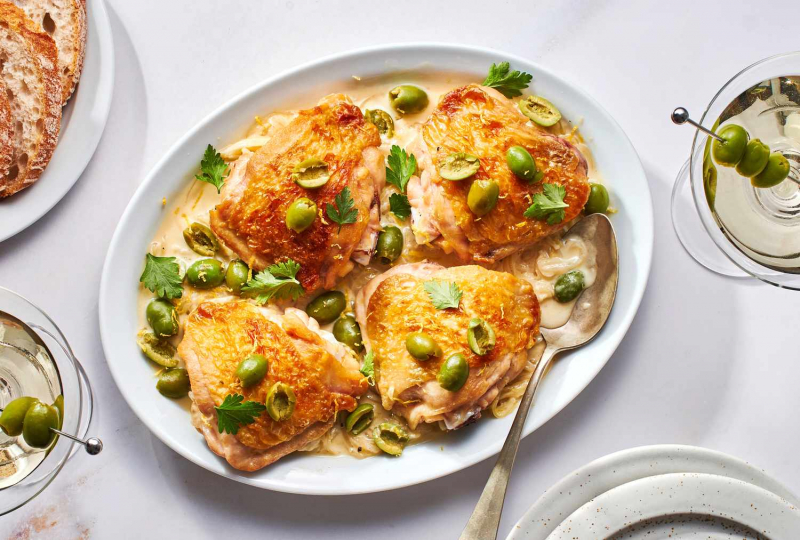
“The flavor in this simple dish is incredible. The vodka and vermouth aren’t overpowering at all—they lend a vaguely adult complexity to the sauce, along with the garlic and onions. The sauce is rich, perfect for sopping up with good bread. This dish will be going in my repertoire. It’s plenty easy for weeknights but good enough for company.” —Megan Scott
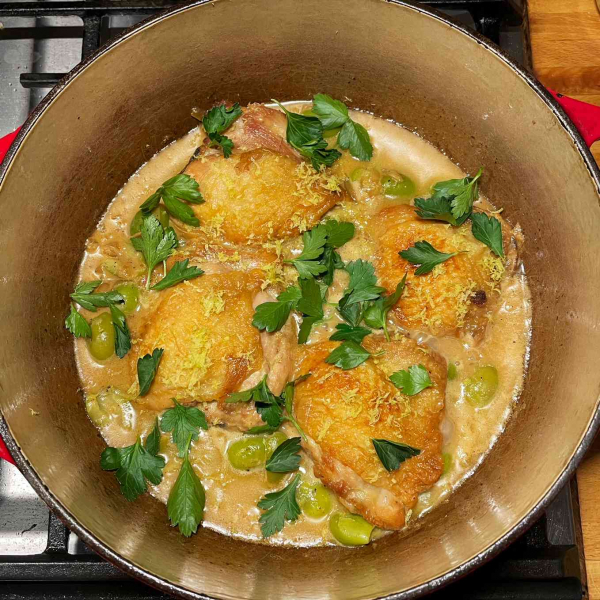
A Note From Our Recipe Tester
Ingredients
For the Braised Chicken:
-
4 bone-in, skin-on chicken thighs
-
1/2 teaspoon fine salt
-
1 tablespoon extra-virgin olive oil
-
2 medium yellow onions, cut in half and thinly sliced into half moons
-
8 garlic cloves, smashed and peeled
-
Freshly ground black pepper
-
1 1/3 cups dry vermouth
-
2 bay leaves (optional)
For the Vodka Sauce:
-
1/2 cup vodka
-
3 whole lemons for zesting, divided
-
2 tablespoons cold unsalted butter, cut into pea-sized pieces
-
Freshly ground black pepper
-
1 heaping cup (6.35 ounces) whole, pitted Castelvetrano olives
-
2 tablespoons mascarpone (or cream cheese in a pinch)
-
1 peeled garlic clove, for microplaning
-
1 handful whole flat-leaf parsley leaves
Steps to Make It
Braise the Chicken
-
Gather the ingredients.
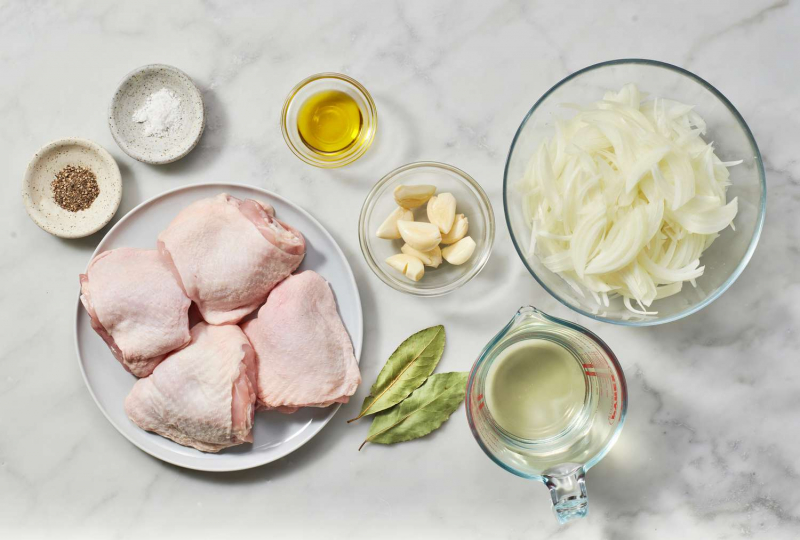
-
Pat the chicken dry with paper towels and sprinkle with salt.
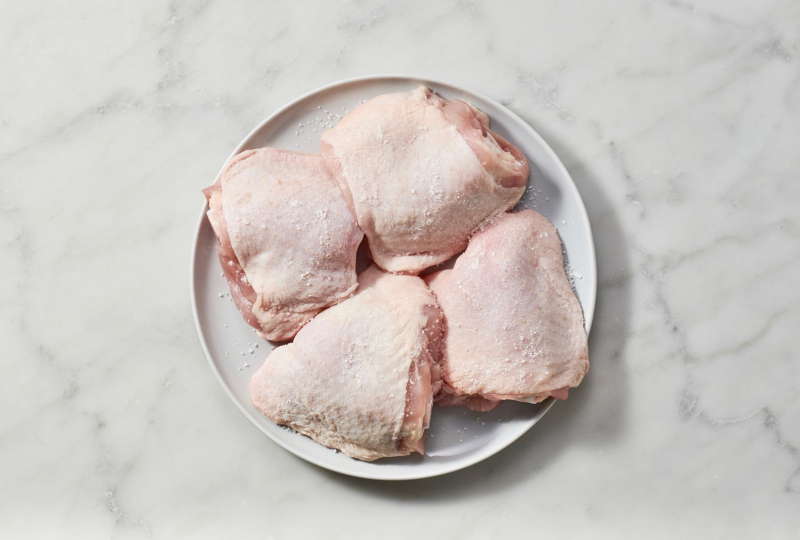
-
Heat the olive oil over medium-high heat in a 5 to 7 quart-sized Dutch oven or heavy bottom pot with a tight fitting lid. When shimmering, place the chicken thighs skin side down in the oil. Cook, undisturbed, until skin is browned and releases easily from the pan, about 8 to 10 minutes. Check the chicken after 4 minutes. If it is browning too quickly, reduce the heat to medium.
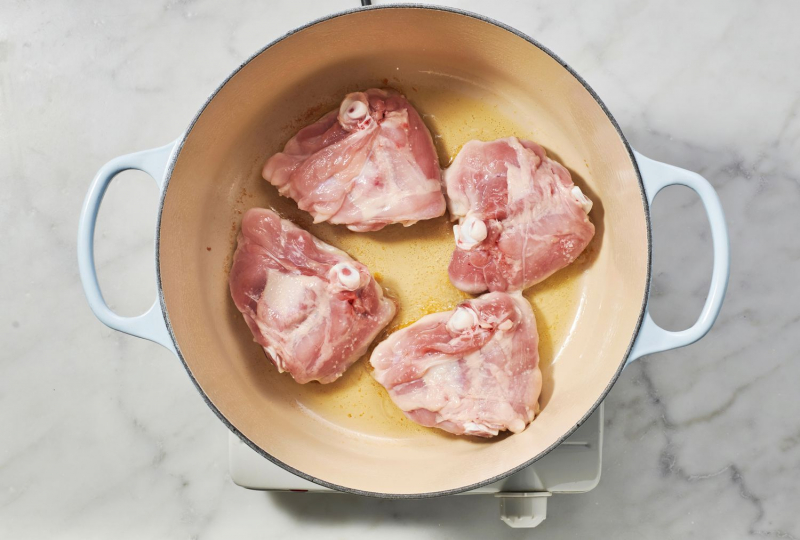
-
Flip the thighs with tongs (use a spatula to help you gently release the chicken skin from the pan if needed) and cook on the other side until golden brown, 3 to 5 minutes. Remove the browned chicken from the pot and set aside.

-
Reduce the heat to medium and add the onion and smashed garlic cloves to the pot with the residual oil and drippings. Toss to coat and then sauté until onions soften and begin to brown around the edges, 6 to 8 minutes, stirring occasionally.
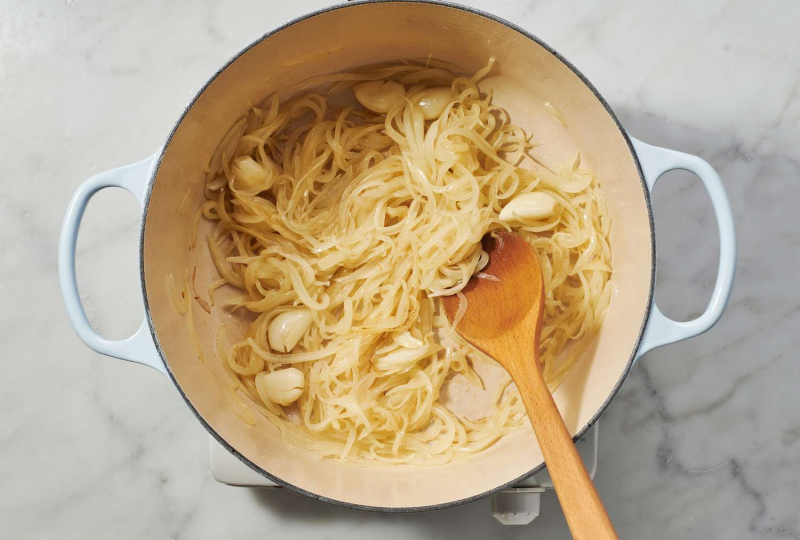
-
Add a few grinds of freshly ground black pepper and then the vermouth and bay leaves, if using. Return the chicken to the pot, skin side up, nestling the thighs into the vermouth mixture. Cover and cook until the chicken is tender and reaches a temperature of 175 on an instant read thermometer, 13 to 17 minutes.
During braising, the liquid in the pot should be at a slow simmer. If you notice the liquid boiling, reduce the heat to medium-low.

Make the Vodka Sauce
-
Gather the ingredients.
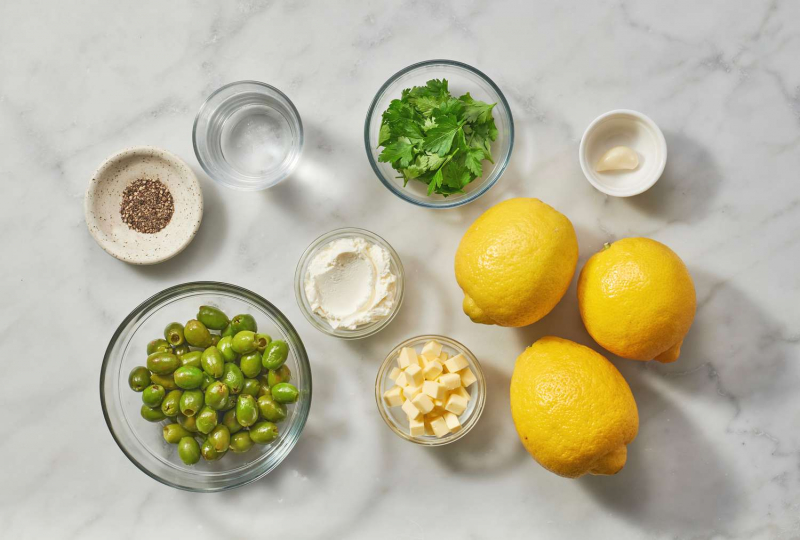
-
Once the chicken is cooked, remove the chicken to a platter. Pick out the bay leaves, if using, and discard.
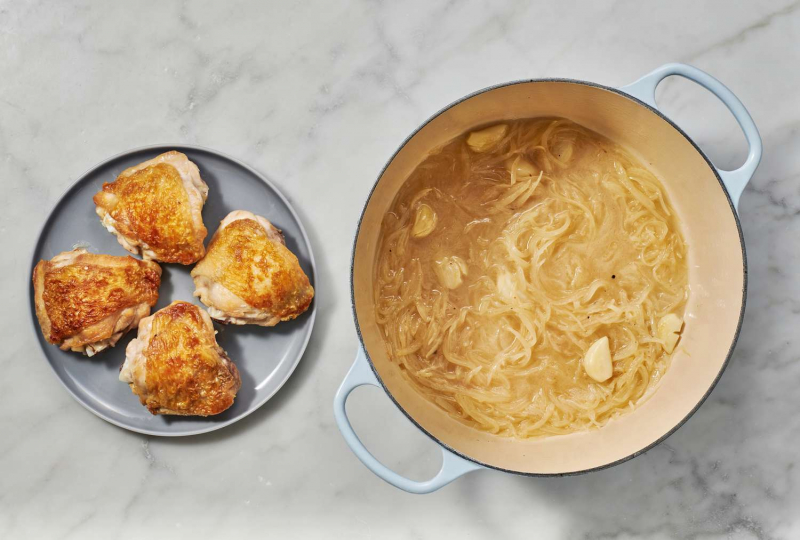
-
Add the vodka to the onion mixture and zest 2 lemons directly over the pot using a microplane. Simmer the sauce over medium heat, uncovered, for 3 minutes. During this time, break up the softened garlic throughout the sauce with a whisk or fork.

-
While the sauce is simmering (but not boiling), mount the sauce with butter by dropping the cold butter, a couple small pieces at a time, into the simmering liquid and whisking constantly. Repeat until all butter has been incorporated and the sauce is shiny and silky.
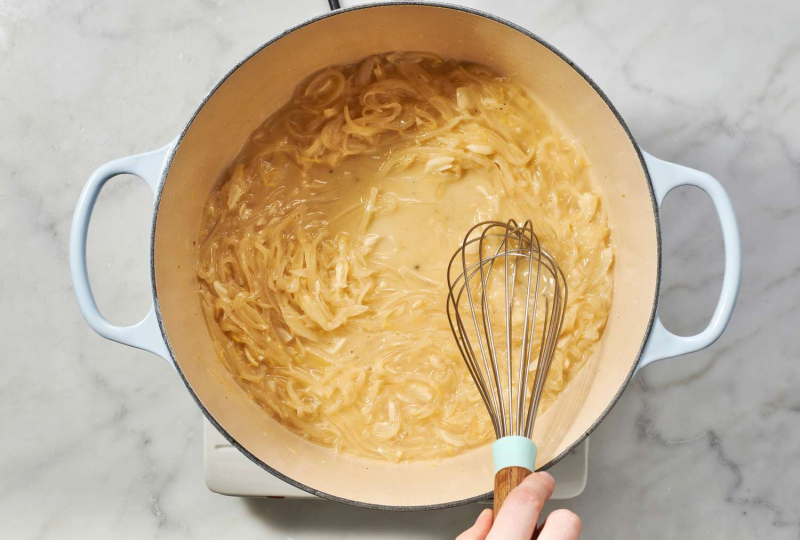
-
Whisk in the mascarpone and grate the fresh garlic clove directly into the sauce using a microplane. Taste the sauce and add a few grinds of black pepper and a little bit more salt, if desired (remember the olives will pack a salty punch, so go light if at all on the salt here). Stir to combine.

-
Return the chicken to the sauce. Scatter the olives over top, crushing some of them in half with your hands as you go. Heat, uncovered, 3 to 4 minutes just to warm the chicken.
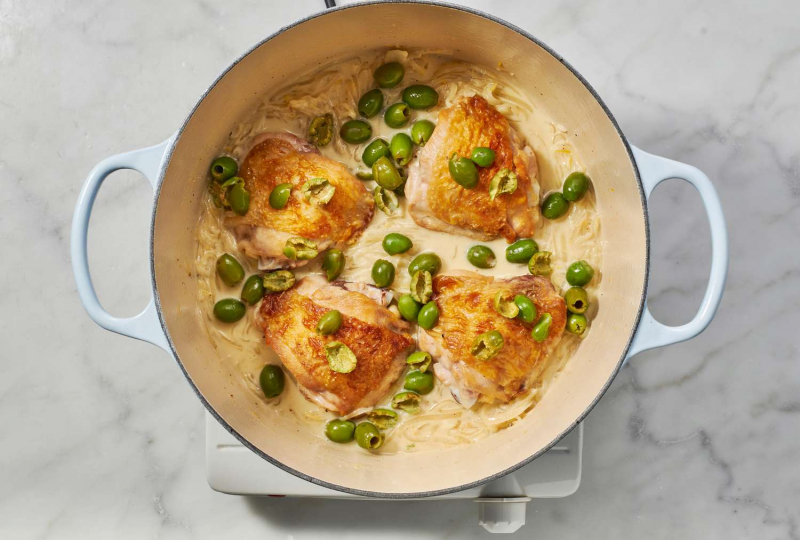
-
To serve, zest the remaining 1 lemon directly over the chicken and garnish with fresh flat leaf parsley sprinkled over top.
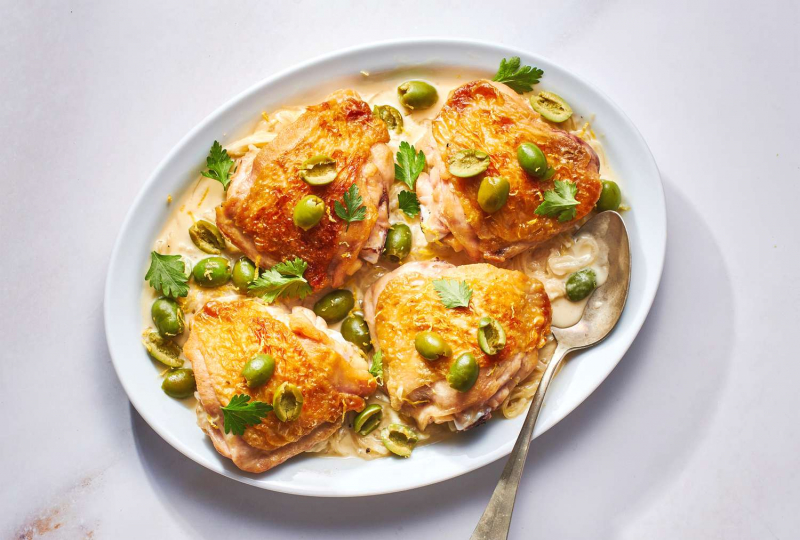
How to Store
- Store leftovers in the refrigerator in an airtight container for up to 4 days.
- Once cooled, the chicken and sauce can be placed in a freezer-safe large resealable plastic bag with as much air pressed out as possible. Thaw frozen chicken in the refrigerator before reheating.
- To reheat the chicken and sauce, you can microwave chicken thighs on high for 2 minutes or place in a pan and bring to a simmer over medium-heat for 5 to 7 minutes until hot. You may need to add a little water to the pan depending on how much sauce you have leftover.
Gin Martini Variation
You can substitute a London dry Gin for the vodka (in equal measure) if you prefer in the sauce. The final result will be a sauce with a bit more botanical juniper flavor, but this will still pair beautifully with the chicken.
| Nutrition Facts | |
|---|---|
| Servings: 4 | |
| Amount per serving | |
| Calories | 861 |
| % Daily Value* | |
| Total Fat 42g | 54% |
| Saturated Fat 14g | 69% |
| Cholesterol 233mg | 78% |
| Sodium 1286mg | 56% |
| Total Carbohydrate 53g | 19% |
| Dietary Fiber 10g | 35% |
| Total Sugars 20g | |
| Protein 43g | |
| Vitamin C 158mg | 789% |
| Calcium 153mg | 12% |
| Iron 4mg | 24% |
| Potassium 1173mg | 25% |
| *The % Daily Value (DV) tells you how much a nutrient in a food serving contributes to a daily diet. 2,000 calories a day is used for general nutrition advice. | |